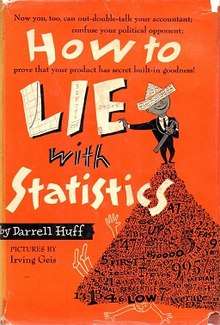How to Lie with Statistics
How to Lie with Statistics is a book written by Darrell Huff in 1954 presenting an introduction to statistics for the general reader. Not a statistician, Huff was a journalist who wrote many "how to" articles as a freelancer.
 First edition | |
| Author | Darrell Huff |
|---|---|
| Illustrator | Irving Geis |
| Publisher | W. W. Norton & Company |
Publication date | 1954 |
The book is a brief, breezy illustrated volume outlining errors when it comes to the interpretation of statistics, and how these errors may create incorrect conclusions.
In the 1960s and 1970s, it became a standard textbook introduction to the subject of statistics for many college students. It has become one of the best-selling statistics books in history, with over one and a half million copies sold in the English-language edition.[1] It has also been widely translated.
Themes of the book include "Correlation does not imply causation" and "Using random sampling". It also shows how statistical graphs can be used to distort reality, for example by truncating the bottom of a line or bar chart, so that differences seem larger than they are, or by representing one-dimensional quantities on a pictogram by two- or three-dimensional objects to compare their sizes, so that the reader forgets that the images do not scale the same way the quantities do.
The original edition contained illustrations by artist Irving Geis. In a UK edition, these were replaced with cartoons by Mel Calman.
Controversy
In the 1960s Huff was funded by the tobacco industry to produce a follow-up book titled How to Lie with Smoking Statistics that attempted to use statistical arguments to undermine claims that smoking was harmful to health. The book was never published but Huff has subsequently been criticised by statisticians for his involvement and the arguments advanced in draft copies.[2][3]
See also
- Freakonomics
- Lies, damned lies, and statistics
- Misuse of statistics
- The Tiger That Isn't, a book on taking numbers out of context
Related books by Darrell Huff
- How to Take a Chance (1959)
- Score: The Strategy of Taking Tests (1961)
- Cycles in Your Life: The Rhythms of War, Wealth, Nature, and Human Behavior (1964)
- How to Figure the Odds on Everything (1972)
- The Complete How to Figure It: Using Math in Everyday Life (1996)
Notes
- "Over the last fifty years, How to Lie with Statistics has sold more copies than any other statistical text." J. M. Steele. "Darrell Huff and Fifty Years of How to Lie with Statistics. Statistical Science, 20 (3), 2005, 205–209.
- "The history of "How to Lie with Smoking Statistics"". www.refsmmat.com. Retrieved 2019-01-30.
- Gelman, Andrew (2012). "Statistics for Cigarette Sellers" (PDF). CHANCE. 25 (3): 43–46. doi:10.1080/09332480.2012.726563.
Sources
- Darrell Huff, (1954) How to Lie with Statistics (illust. I. Geis), Norton, New York, ISBN 0-393-31072-8
- Darrell Huff, (1991) How to Lie with Statistics Penguin; New Ed edition, ISBN 0-14-013629-0
External links
| Wikiquote has quotations related to: How to Lie with Statistics |
- Book review at www.mooreds.com
- Book review at plus.maths.org
- Book reviews at goodreads.com
- Book readable online: https://archive.org/details/HowToLieWithStatistics